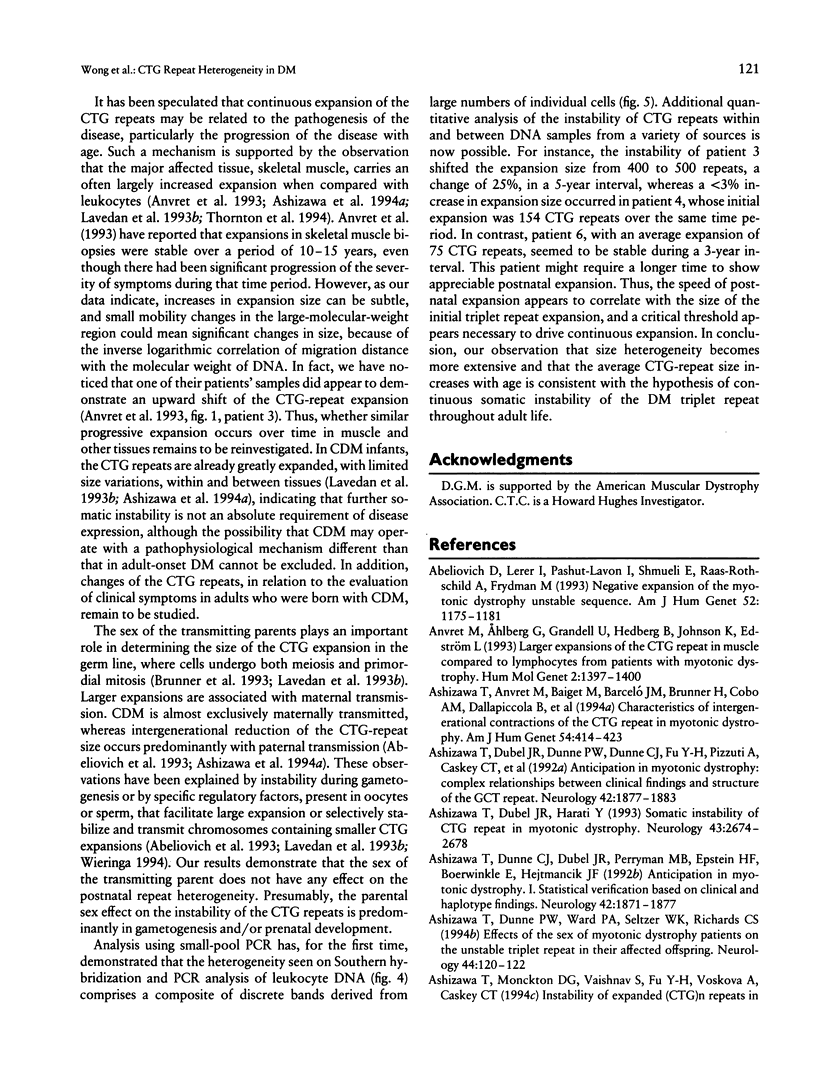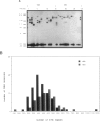Abstract
The most common form of adult muscular dystrophy, myotonic dystrophy (DM), is caused by the abnormal expansion of the CTG repeat, located in the 3' UTR of the DM gene. The expanded-CTG allele often presents as a diffused band on Southern blot analysis, suggesting somatic mosaicism. In order to study the somatic instability of the CTG repeat, we have investigated the dynamics of the size heterogeneity of the CTG expansion. Size heterogeneity is shown as a smear on Southern blot and is measured by the midpeak-width ratio of the expanded allele to the normal sized allele. The ratio is also corrected for compression in the higher-molecular-weight region. It is found that the size heterogeneity of the expanded-CTG repeats, of 173 DM patients, correlates well with the age of the patient (r = .81, P << .001). The older patients show larger size variation. This correlation is independent of the sex of either the patient or the transmitting parent. The size heterogeneity of the expansion, based on age groups, is also dependent on the size of the expanded trinucleotide repeat. However, obvious size heterogeneity is not observed in congenital cases, regardless of the size of expansion. Comparison of individual patient samples collected at two different times has confirmed that the degree of size heterogeneity increases with age and has revealed a subtle but definite upward shift in the size of the expanded-CTG allele. The progression of the CTG repeat toward larger expansion with age is further confirmed by small-pool PCR assay that resolved the heterogeneous fragments into discrete bands.(ABSTRACT TRUNCATED AT 250 WORDS)
Full text
PDF








Images in this article
Selected References
These references are in PubMed. This may not be the complete list of references from this article.
- Abeliovich D., Lerer I., Pashut-Lavon I., Shmueli E., Raas-Rothschild A., Frydman M. Negative expansion of the myotonic dystrophy unstable sequence. Am J Hum Genet. 1993 Jun;52(6):1175–1181. [PMC free article] [PubMed] [Google Scholar]
- Anvret M., Ahlberg G., Grandell U., Hedberg B., Johnson K., Edström L. Larger expansions of the CTG repeat in muscle compared to lymphocytes from patients with myotonic dystrophy. Hum Mol Genet. 1993 Sep;2(9):1397–1400. doi: 10.1093/hmg/2.9.1397. [DOI] [PubMed] [Google Scholar]
- Ashizawa T., Anvret M., Baiget M., Barceló J. M., Brunner H., Cobo A. M., Dallapiccola B., Fenwick R. G., Jr, Grandell U., Harley H. Characteristics of intergenerational contractions of the CTG repeat in myotonic dystrophy. Am J Hum Genet. 1994 Mar;54(3):414–423. [PMC free article] [PubMed] [Google Scholar]
- Ashizawa T., Dubel J. R., Dunne P. W., Dunne C. J., Fu Y. H., Pizzuti A., Caskey C. T., Boerwinkle E., Perryman M. B., Epstein H. F. Anticipation in myotonic dystrophy. II. Complex relationships between clinical findings and structure of the GCT repeat. Neurology. 1992 Oct;42(10):1877–1883. doi: 10.1212/wnl.42.10.1877. [DOI] [PubMed] [Google Scholar]
- Ashizawa T., Dubel J. R., Harati Y. Somatic instability of CTG repeat in myotonic dystrophy. Neurology. 1993 Dec;43(12):2674–2678. doi: 10.1212/wnl.43.12.2674. [DOI] [PubMed] [Google Scholar]
- Ashizawa T., Dunne C. J., Dubel J. R., Perryman M. B., Epstein H. F., Boerwinkle E., Hejtmancik J. F. Anticipation in myotonic dystrophy. I. Statistical verification based on clinical and haplotype findings. Neurology. 1992 Oct;42(10):1871–1877. doi: 10.1212/wnl.42.10.1871. [DOI] [PubMed] [Google Scholar]
- Ashizawa T., Dunne P. W., Ward P. A., Seltzer W. K., Richards C. S. Effects of the sex of myotonic dystrophy patients on the unstable triplet repeat in their affected offspring. Neurology. 1994 Jan;44(1):120–122. doi: 10.1212/wnl.44.1.120. [DOI] [PubMed] [Google Scholar]
- Aslanidis C., Jansen G., Amemiya C., Shutler G., Mahadevan M., Tsilfidis C., Chen C., Alleman J., Wormskamp N. G., Vooijs M. Cloning of the essential myotonic dystrophy region and mapping of the putative defect. Nature. 1992 Feb 6;355(6360):548–551. doi: 10.1038/355548a0. [DOI] [PubMed] [Google Scholar]
- Brook J. D., McCurrach M. E., Harley H. G., Buckler A. J., Church D., Aburatani H., Hunter K., Stanton V. P., Thirion J. P., Hudson T. Molecular basis of myotonic dystrophy: expansion of a trinucleotide (CTG) repeat at the 3' end of a transcript encoding a protein kinase family member. Cell. 1992 Feb 21;68(4):799–808. doi: 10.1016/0092-8674(92)90154-5. [DOI] [PubMed] [Google Scholar]
- Brunner H. G., Jansen G., Nillesen W., Nelen M. R., de Die C. E., Höweler C. J., van Oost B. A., Wieringa B., Ropers H. H., Smeets H. J. Brief report: reverse mutation in myotonic dystrophy. N Engl J Med. 1993 Feb 18;328(7):476–480. doi: 10.1056/NEJM199302183280705. [DOI] [PubMed] [Google Scholar]
- Buxton J., Shelbourne P., Davies J., Jones C., Van Tongeren T., Aslanidis C., de Jong P., Jansen G., Anvret M., Riley B. Detection of an unstable fragment of DNA specific to individuals with myotonic dystrophy. Nature. 1992 Feb 6;355(6360):547–548. doi: 10.1038/355547a0. [DOI] [PubMed] [Google Scholar]
- Devys D., Biancalana V., Rousseau F., Boué J., Mandel J. L., Oberlé I. Analysis of full fragile X mutations in fetal tissues and monozygotic twins indicate that abnormal methylation and somatic heterogeneity are established early in development. 1992 Apr 15-May 1Am J Med Genet. 43(1-2):208–216. doi: 10.1002/ajmg.1320430134. [DOI] [PubMed] [Google Scholar]
- Dubel J. R., Armstrong R. M., Perryman M. B., Epstein H. F., Ashizawa T. Phenotypic expression of the myotonic dystrophy gene in monozygotic twins. Neurology. 1992 Sep;42(9):1815–1817. doi: 10.1212/wnl.42.9.1815. [DOI] [PubMed] [Google Scholar]
- Fu Y. H., Pizzuti A., Fenwick R. G., Jr, King J., Rajnarayan S., Dunne P. W., Dubel J., Nasser G. A., Ashizawa T., de Jong P. An unstable triplet repeat in a gene related to myotonic muscular dystrophy. Science. 1992 Mar 6;255(5049):1256–1258. doi: 10.1126/science.1546326. [DOI] [PubMed] [Google Scholar]
- Harley H. G., Brook J. D., Rundle S. A., Crow S., Reardon W., Buckler A. J., Harper P. S., Housman D. E., Shaw D. J. Expansion of an unstable DNA region and phenotypic variation in myotonic dystrophy. Nature. 1992 Feb 6;355(6360):545–546. doi: 10.1038/355545a0. [DOI] [PubMed] [Google Scholar]
- Harley H. G., Rundle S. A., Reardon W., Myring J., Crow S., Brook J. D., Harper P. S., Shaw D. J. Unstable DNA sequence in myotonic dystrophy. Lancet. 1992 May 9;339(8802):1125–1128. doi: 10.1016/0140-6736(92)90729-m. [DOI] [PubMed] [Google Scholar]
- Harper P. S., Harley H. G., Reardon W., Shaw D. J. Anticipation in myotonic dystrophy: new light on an old problem. Am J Hum Genet. 1992 Jul;51(1):10–16. [PMC free article] [PubMed] [Google Scholar]
- Jansen G., Willems P., Coerwinkel M., Nillesen W., Smeets H., Vits L., Höweler C., Brunner H., Wieringa B. Gonosomal mosaicism in myotonic dystrophy patients: involvement of mitotic events in (CTG)n repeat variation and selection against extreme expansion in sperm. Am J Hum Genet. 1994 Apr;54(4):575–585. [PMC free article] [PubMed] [Google Scholar]
- Jeffreys A. J., Tamaki K., MacLeod A., Monckton D. G., Neil D. L., Armour J. A. Complex gene conversion events in germline mutation at human minisatellites. Nat Genet. 1994 Feb;6(2):136–145. doi: 10.1038/ng0294-136. [DOI] [PubMed] [Google Scholar]
- Kruyer H., Milà M., Glover G., Carbonell P., Ballesta F., Estivill X. Fragile X syndrome and the (CGG)n mutation: two families with discordant MZ twins. Am J Hum Genet. 1994 Mar;54(3):437–442. [PMC free article] [PubMed] [Google Scholar]
- Lavedan C., Hofmann-Radvanyi H., Rabes J. P., Roume J., Junien C. Different sex-dependent constraints in CTG length variation as explanation for congenital myotonic dystrophy. Lancet. 1993 Jan 23;341(8839):237–237. doi: 10.1016/0140-6736(93)90097-z. [DOI] [PubMed] [Google Scholar]
- Lavedan C., Hofmann-Radvanyi H., Shelbourne P., Rabes J. P., Duros C., Savoy D., Dehaupas I., Luce S., Johnson K., Junien C. Myotonic dystrophy: size- and sex-dependent dynamics of CTG meiotic instability, and somatic mosaicism. Am J Hum Genet. 1993 May;52(5):875–883. [PMC free article] [PubMed] [Google Scholar]
- López de Munain A., Cobo A. M., Huguet E., Marti Massó J. F., Johnson K., Baiget M. CTG trinucleotide repeat variability in identical twins with myotonic dystrophy. Ann Neurol. 1994 Mar;35(3):374–375. doi: 10.1002/ana.410350323. [DOI] [PubMed] [Google Scholar]
- Mahadevan M., Tsilfidis C., Sabourin L., Shutler G., Amemiya C., Jansen G., Neville C., Narang M., Barceló J., O'Hoy K. Myotonic dystrophy mutation: an unstable CTG repeat in the 3' untranslated region of the gene. Science. 1992 Mar 6;255(5049):1253–1255. doi: 10.1126/science.1546325. [DOI] [PubMed] [Google Scholar]
- Malmgren H., Steén-Bondeson M. L., Gustavson K. H., Seémanova E., Holmgren G., Oberlé I., Mandel J. L., Pettersson U., Dahl N. Methylation and mutation patterns in the fragile X syndrome. 1992 Apr 15-May 1Am J Med Genet. 43(1-2):268–278. doi: 10.1002/ajmg.1320430142. [DOI] [PubMed] [Google Scholar]
- Mulley J. C., Staples A., Donnelly A., Gedeon A. K., Hecht B. K., Nicholson G. A., Haan E. A., Sutherland G. R. Explanation for exclusive maternal origin for congenital form of myotonic dystrophy. Lancet. 1993 Jan 23;341(8839):236–237. doi: 10.1016/0140-6736(93)90096-y. [DOI] [PubMed] [Google Scholar]
- Reyniers E., Vits L., De Boulle K., Van Roy B., Van Velzen D., de Graaff E., Verkerk A. J., Jorens H. Z., Darby J. K., Oostra B. The full mutation in the FMR-1 gene of male fragile X patients is absent in their sperm. Nat Genet. 1993 Jun;4(2):143–146. doi: 10.1038/ng0693-143. [DOI] [PubMed] [Google Scholar]
- Richards R. I., Sutherland G. R. Dynamic mutations: a new class of mutations causing human disease. Cell. 1992 Sep 4;70(5):709–712. doi: 10.1016/0092-8674(92)90302-s. [DOI] [PubMed] [Google Scholar]
- Shelbourne P., Winqvist R., Kunert E., Davies J., Leisti J., Thiele H., Bachmann H., Buxton J., Williamson B., Johnson K. Unstable DNA may be responsible for the incomplete penetrance of the myotonic dystrophy phenotype. Hum Mol Genet. 1992 Oct;1(7):467–473. doi: 10.1093/hmg/1.7.467. [DOI] [PubMed] [Google Scholar]
- Thornton C. A., Johnson K., Moxley R. T., 3rd Myotonic dystrophy patients have larger CTG expansions in skeletal muscle than in leukocytes. Ann Neurol. 1994 Jan;35(1):104–107. doi: 10.1002/ana.410350116. [DOI] [PubMed] [Google Scholar]
- Wieringa B. Myotonic dystrophy reviewed: back to the future? Hum Mol Genet. 1994 Jan;3(1):1–7. doi: 10.1093/hmg/3.1.1-a. [DOI] [PubMed] [Google Scholar]
- Wöhrle D., Hennig I., Vogel W., Steinbach P. Mitotic stability of fragile X mutations in differentiated cells indicates early post-conceptional trinucleotide repeat expansion. Nat Genet. 1993 Jun;4(2):140–142. doi: 10.1038/ng0693-140. [DOI] [PubMed] [Google Scholar]





